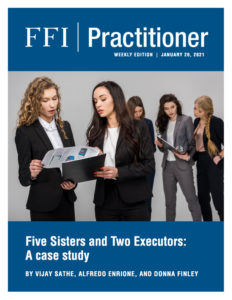
View this edition in our enhanced digital edition format with supporting visual insight and information.
Thanks to Vijay Sathe, Alfredo Enrione, Donna Finley for this week’s edition, which is a case study about how five sisters, who suddenly and unexpectedly inherited their father’s businesses, and how they dealt with the influence of two executors to reach harmonious ownership of the family enterprise.
Background
Stuart Campbell was a self-made Australian billionaire. Most of his wealth was tied up in one of the country’s largest mines, but he was also partial owner of a film production company in the UK, a tech start-up in Silicon Valley, and a number of smaller companies around the world. Stuart was not much for governance, organization structure, or formal systems.
Stuart was married and had five daughters. The first two, in their late 30s, had worked in their father’s businesses in administrative roles and had left the firm when they got married and had children. The other three daughters were all single. The third daughter was a successful op-ed writer on political issues who published under a pseudonym in order to protect the family name, and the two youngest were finishing college. Stuart’s two oldest daughters and their families lived separately but the Campbell clan met regularly and enjoyed being together on holidays.
Everything changed when Stuart died suddenly in a car accident in 2013. Stuart had left a simple irrevocable trust, with only one directive: his estate was to be divided equally among his five daughters, who were to work out an Australian Shareholders Agreement (ASA) in order to access their inheritance.
Six months before Stuart died, he had held the family’s first succession planning meeting. It did not lead to any results or actions. Stuart had left no plan for transition or succession, and the beneficiaries found themselves unprepared to take over Stuart’s huge mining business and other investments around the world.
The five sisters spanned a range of life stages, interests, ambitions, experience, and knowledge of the business. They had a very tough time in the first couple of years, a period they described as “super stressful and very emotional” because of both external pressures and internal challenges.
The Two Executors
Stuart had appointed two outside executors for his estate. The two told the sisters that Stuart had asked them to help his five daughters “run his businesses after he died because they didn’t know how to run a business or speak the language of business.”
The five sisters, the sole beneficiaries of Stuart’s vast wealth, felt they had no control over their father’s estate. They couldn’t make any decision without the executors’ approval, nor could they remove the executors because they had no power to do so. Their mother was of no help because she told them they needed to listen to the executors if the business was going to survive. The sisters felt that the two executors had created lifetime jobs for themselves: they were paying themselves large salaries and had entrenched themselves in their positions. It didn’t look like they had plans to leave any time soon.
The five sisters knew they didn’t have the tools, knowledge, or experience to manage the businesses on their own, so they hired experts and advisors to help them develop governance structures, leadership skills, and strategy for the family. They decided that they would become the only directors of the board of the family’s business empire and appointed the oldest as CEO and the next oldest as COO. They worked out an agreement with the executors and paid them a substantial amount of money to leave.
Stuart’s businesses were registered in a variety of countries and Australian provinces, which created considerable tax and reporting complications, as well as uncertainty about which sister from which province was eligible to be a Director in what business. In addition, they needed to determine what to do with multiple unrelated investments that didn’t necessarily fit together.
A significant internal challenge was that Stuart had created a bloated and top-heavy staff – a result of his unwillingness to fire anyone. He had long-serving senior employees with big titles but little to do. These people needed to be retired or removed but they pushed back, claiming that Stuart had promised them lifetime employment. When some of these people were eventually terminated, they filed “unfair dismissal” lawsuits, some of which were complex and demanded large settlements.
It took four years for the five sisters to finalize an Australian Shareholder Agreement (ASA) with the help of a process consultant who had earned their trust. Each sister had an equal share in the joint estate and an equal vote on the five-person board governing all the family’s businesses.
Lessons for Advisors
What are the lessons for family business practitioners? First, there are lessons we have already learned that are re-confirmed in the experience of these five sisters. Far too many family business leaders die without preparing their family for succession. Second, trustees appointed because they have earned the complete confidence of the family business leader may abuse this trust in their self-interest.
But there are also uncommon facets to this story from which we can all learn. First, the role of women in family business deserves further study. There are far too few examples like this one where women (in this case five sisters) had to persevere to get the trustees out and run their father’s businesses as they saw fit. Second, the role played by their process consultant in helping to build their business knowledge and skills is noteworthy.
Finally, the simple legal requirement of their father’s irrevocable trust “forced” the five sisters to engage in a process of inquiry to figure out what they wanted to do with their inherited wealth, starting with the question of whether they even wanted to work together as a family business! As a key finding in psychology reminds us, it is the perception of choice that helps to build commitment. Since the five sisters chose their path of their free will, they were highly committed to the direction they settled on. This resulted not only in better business performance but also greater harmony among the five sisters and their families.

Vijay Sathe is the C. S. & D. J. Davidson chair and Professor of Management at the Drucker School in Claremont, California, which recently launched the Global Family Business Institute. Vijay Sathe can be reached at vijayvsathe@gmail.com.

Alfredo Enrione is The PricewaterhouseCoopers Professor of Corporate Governance at ESE Business School in Chile and is Chancellor of the International Academy of Management. Alfredo Enrione can be reached at aenrione@gmail.com.

Donna Finley is the founder and senior strategist at Finley & Associates in Calgary, Canada, and Senior Fellow at the Drucker School in Claremont, California. Donna Finley can be reached at donna@finleyandassociates.com.

View this edition in our enhanced digital edition format with supporting visual insight and information.





